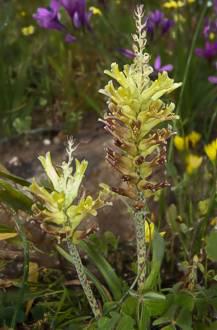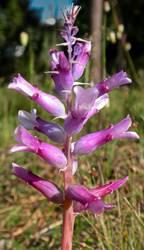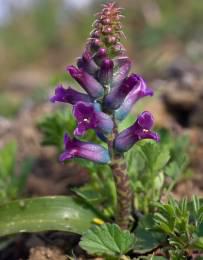Lachenalia orchioides
Lachenalia orchioides (L.) Ait.
Family: Hyacinthaceae
Common names: (L. orchioides var. orchioides): wild hyacinth (Eng.), groenviooltjie (Afr.); (L. orchioides var. glaucina (Jacq.) W.F.Barker): blue wild hyacinth (Eng.), blouviooltjie (Afr.)
Introduction
Large strikingly attractive flowers varying in colour through shades of blue, pink, lilac to bright yellow and green make this species an attractive container or garden plant.

Description
Description
Lachenalia orchioides consists of a single white fleshy bulb about 10-20 mm in diameter, fine white adventitious roots, and two strap-like lanceolate leaves up to 150 mm long. In some individuals these leaves are covered in dark blotches, whereas in others they are plain green. They never have little bumps or pustules which are quite common in certain other Lachenalia species. The leaves start to emerge a few weeks after the first rains in autumn and wither naturally in late spring/early summer.
The inflorescence can grow up to about 200 mm tall and appears in early to middle spring. Typically in L. orchioides the inner perianth segments of the flower are significantly longer than the outer segments. The fruit are small capsules that ripen a month or two after flowering to release small shiny black seeds.
Flower colour varies depending on the variety, of which there are two: L. orchioides var. orchioides and L. orchioides var. glaucina. The flower colour of both varieties fades to a dull red brown.
- L. orchioides var. orchioides can have a pale blue base, and shades to a typically greenish-yellow or, less commonly in populations on the southern Cape Peninsula, to cream or pure white, sometimes with a blue tinge throughout. Variety orchioides is also quite sweetly scented.

- L. orchioides var. glaucina has flowers with outer perianth segments that are bluish at the base shading to dark blue or dark cerise-pink, and the longer inner segments are a pale blue to pale cerise.

- There is a dwarf, small-flowered form of this variety on the lower slopes of Devil's Peak which has much darker markings.

Distribution and habitat
Distribution description
The genus Lachenalia is generally restricted to the winter-rainfall parts of South Africa and Namibia. L. orchioides is found in the southern Western Cape. The variety L. orchioides var. orchioides occurs fairly commonly on flats or stony slopes from the Cape Peninsula to as far north as the Clanwilliam area, as far east as Swellendam and as far inland as Worcester. The variety L. orchioides var. glaucina is restricted to the eastern slopes of Table Mountain on the Cape Peninsula, often occurring in more shady habitats in rocky soils.
Derivation of name and historical aspects
History
The genus Lachenalia was first described by Joseph Franz Jacquin, son of a Baron Joseph Jacquin, who was studying the collections of these new plants in the Schönbrunn Palace Gardens near Vienna in the late 1700s. He named the genus after Werner de Lachenal, a professor of Botany in Basel, Switzerland.
The species Lachenalia orchioides was described some time later by William Aiton (1731-1793), one of the first curators of the Royal Botanical Gardens at Kew. Ochioides refers seemingly to its orchid-like scent, and the variety name glaucina refers to the blue-grey flowers of that variety.
Ecology
Ecology
Like all other Lachenalia species, L. orchioides is a typical winter-growing bulb that is summer-deciduous, i.e. it becomes completely dormant during the hot dry summer months in the Mediterranean-type climate of the Western Cape.
L. orchioides typically grows in stony soils favouring hilly slopes and flats but today much of this area has given way to farming and urban sprawl. L. orchioides var. orchioides tends to grow more in the open and L. orchioides var. glaucina favours more shady positions along forest margins and in low bush. The soil consists mainly of clay and is usually quite stony, which prevents predation by moles and/or porcupines. The sweet scent of the flowers indicates that they are probably pollinated by bees.
Uses
Use
Lachenalia are considered to be one of the most rewarding groups of Cape winter-growing bulbs to cultivate, one of their virtues being their vast array of flower colours in practically every colour of the rainbow.
Growing Lachenalia orchioides
Grow
L. orchioides is very easy to grow and is one of the most rewarding species to grow as a pot subject. The soil medium should be fairly well-drained and consist of about half coarse washed sand and half finely sieved compost. This should be used to fill the lower two-thirds of the pot. The upper third should be pure sand with no loam or compost into which the bulbs are planted. This layer stays relatively dry preventing the bulbs from rotting if they get too wet, while the roots can safely penetrate the richer moister organic medium below. The plants should be kept in full sun and will grow very happily outside during the winter months, providing the temperature does not drop below freezing. In summer the bulbs should be kept dry, preferably in a cool position. One may either lift the bulbs and store them in paper bags or store them in their pots. They enjoy being repotted every 2-3 years with fresh medium.
They are easily propagated by leaf cuttings, which can be removed from the plant by slicing them at the base of the leaf blade. These leaves are then half-buried in a very sandy medium and left in a cool place out of direct sunlight. The soil should be kept on the dry side to avoid the leaves rotting while the humidity can be quite high: humid air and dry soil is the trick. Within a few months, small bulbils will appear along the cut edge at the base of the leaf. Eventually the leaf will wither but the bulbils can be planted like normal bulbs the following season. Flowering will take 1-2 years.
They are also easily raised from seed, which should be sown in autumn in a similar medium used for cultivation with a thin layer of soil placed over the seed. Water them gently but regularly in the first few weeks. The seedlings should germinate within about 2-3 weeks. Flowering will take 2-3 years.
They don't have many pests apart from snails and caterpillars (which can be removed by hand) and mealy bug which should be treated with a systemic pesticide. A rust fungus can be problematic and appears as orange blotches on the leaves, often developing where a leaf has been damaged by hail, for example. This is easily preventable (preferable) or treatable with common fungicides.
Not much fertilising is required for these bulbs as they are not generally very hungry, but they wouldn't be adverse to the odd splash of a dilute low-nitrogen liquid fertiliser.
References
- Duncan, G.D. 1988. The Lachenalia handbook. National Botanical Institute, Cape Town.
- Manning, J., Goldblatt, P. & Snijman, D. 2002. The color encyclopedia of Cape bulbs. Timber Press, Oregon.
Credits
Adam Harrower
Kirstenbosch Botanical Garden
July 2011
Plant Attributes:
Plant Type: Bulb
SA Distribution: Western Cape
Soil type:
Flowering season: Spring
PH:
Flower colour: Blue, Green, Purple, White, Pink, Cream, Yellow, Mauve/Lilac
Aspect:
Gardening skill: Easy
Special Features:
Horticultural zones







Rate this article
Article well written and informative
Rate this plant
Is this an interesting plant?
Login to add your Comment
Back to topNot registered yet? Click here to register.